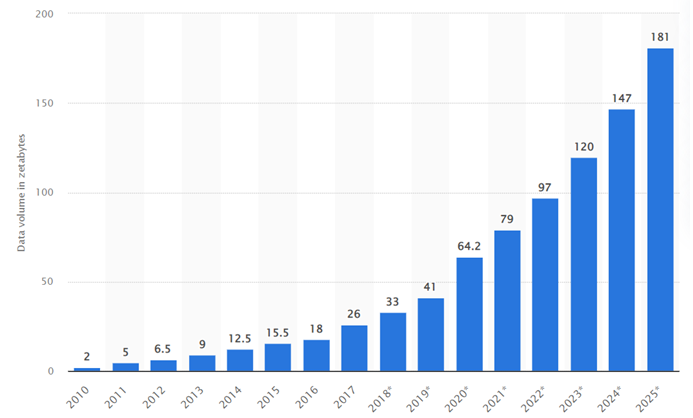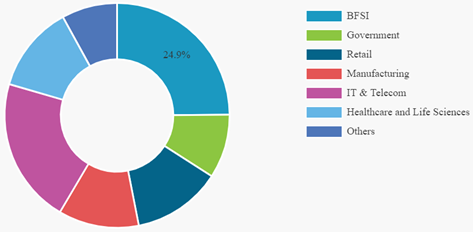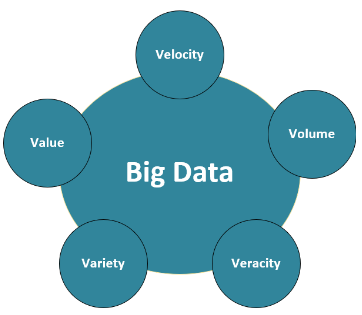The Data analytics landscape
So, what all this fuzz is about data analytics? Data analytics is am umbrella term used to describe a collection of techniques and tools for data modelling, data inspection and data processing. Their goal is extract insights from a large volume of data. For this purpose, there is a large number of techniques that can be employed such as artificial intelligence, data mining and statistical methods. Data analytics are very popular within enterprises since large businesses deal with huge amounts of data. Therefore, the data analytics market is a growing one and is expected to grow more in the following years.
Data analytics markets
During the past few years, more than 85% of the total digital volume is generated. This growth is attributed to the growing trend of inter-connected devices (Laptops, Desktops, IoT, mobile phones, security systems, cameras etc.) and thus, organizations require access to this data in order to optimize their decision-making. Although estimates vary, most expert agree that the global data & business analytics market size was valued very high (200 – 600 Billion dollars) and is expected to reach USD 684 Billion by 2030, having at least a 13% annual growth rate. It is clear that emerging technologies such as cloud computing and IoT play a significant role for this increase. Also, the growing need for better insights for company planning, as well as rising trends such as social media analysis, are likely to provide growth opportunities for the data analytics solutions. One other major factor driving the growth is the COVID-19 pandemic, which has increased the demand for digital commodities, and positively affected the demand for remote services, while also increasing the need for real-time information to track and monitor the COVID-19 spread. Another growth-contributing factor is the constantly growing infrastructures (edge computing, 5G) and emerging technologies (such as edge storage, edge computing and Industrial Internet of Things).

Digital data generation from 2010 to 2025. Figure taken from: https://www.statista.com/statistics/871513/worldwide-data-created/
Data analytics in the energy sector
Data analytics solutions usually specialize in different market sectors such as banking, financial services and insurance (BFSI), governance, manufacturing, information technologies, healthcare and energy. Despite the fact the BFSI sector has acquired the largest share of the market, the energy and utility industry (amongst the “other” sectors of the following figure) is currently undergoing a large-scale transformation due to the advent of advanced technologies. Here, we should also consider the scarcity of fossil fuel, the ongoing energy crisis and the turn to alternate sources of energy such as solar, wave, and wind turbines. All these factors have increased the demand for analytics tools to understand the behaviour or adaption of these (green) sources of energy.

Global data analytics market by vertical. Figure taken from: https://www.fortunebusinessinsights.com/big-data-analytics-market-106179
Recent trends
Energy providers and operators employ smart technologies, such as sensors, cloud computing, wireless, power planning, network communication and smart grids. These kind of infrastructure produces large volumes of data, which get collected over a period of time. Hence the need for quality information is also likely to aid the market growth.
The data analytics market in the energy sector are expected to grow by an average of 11.28% annually, until 2026. There are 3 data analytics trends in the energy domain:
- Analytics related to smart metering applications, such as grid operations, field services, resource planning and customer experience. Such solutions help to predict demand and forecast based on the data collected, which is likely to boost the market growth. The smart meter industry alone is considered to be the greatest contributor of data to the decision-making process.
- Analytics that help in forecasting the energy consumption, which play a vital role in the management of demand and supply, and in the minimization of the waste of energy. Such predictive analytics use the historical data collected at a plant or a household, and search for the relationships that improve the performance and reduce operating costs at the facility/household.
- Analytics and data management tools for simulation purposes which are frequently used to simulate end production and energy distribution operations. Such tools, may help the energy sector save significant costs over time. Thus, companies tend to use reality modelling to capture real-world conditions resulting in less-expensive than traditional survey techniques.
State of the market
Major data analytics players, already have large market shares. Also, due to the lack of skilled workforce with analytical skills and expertise, along with the rising of privacy concerns & data breaches, new players are finding difficulties to enter in the market. High initial capital investment is also restricting new players to enter the market. The world stage of data analytics is dominated by North America. This is attributed to increasing adoption of advanced management solutions by prominent e-commerce companies that are likely to rise the demand for innovative data analytics in the energy sector in the region until 2027. On the other hand, Europe is expected to hold the second position in the market due to the presence of established logistics networks in the region.
State of the market
EVIDENT project invests in data analytics and utilizes a set of techniques to analyse their role in assessing the impact of Behavioural Insights in energy consumption. For this reason, a set of methodologies will be employed on data collected by the consortium (PPC and CW) and tools will be developed to make predictions for future data points. Data collected by the project will exhibit the properties of the so called big data. Such characteristics are also referred as the ‘5Vs’ , namely Volume, Velocity, Variety, Veracity, and Value.
- Volume refers to collecting massive amounts of data originating from multiple sources.
- Velocity refers to the increasing speed of generating, processing, analysing, and storing data in appropriate formats.
- Variety refers to the heterogeneity of the data and their origins.
- Veracity is concerned with the accuracy and quality of the data. In essence, it refers to the level of trustiness associated with the data.
- Value refers to the outcomes that are generated by the processing of the data.

Big Data 5Vs
 This project has received funding from the European Union’s Horizon 2020 research and innovation programme under grant agreement No
This project has received funding from the European Union’s Horizon 2020 research and innovation programme under grant agreement No